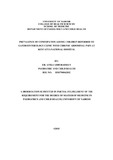| dc.contributor.author | Atika, Abdurahaman | |
| dc.date.accessioned | 2016-04-20T12:59:45Z | |
| dc.date.available | 2016-04-20T12:59:45Z | |
| dc.date.issued | 2015 | |
| dc.identifier.uri | http://hdl.handle.net/11295/94410 | |
| dc.description.abstract | Background: Chronic abdominal pain is one of the most common presenting complaints
to primary care providers and pediatricians. Chronic abdominal pain in children is
generally believed to be functional, and its treatment cause can be a challenge. Studies in
developed countries have shown that constipation is one of the most common diagnoses
in children presenting with chronic abdominal pain. Constipation and its associated
symptoms adversely affect the quality of life of the child and his or her family if left
untreated. There is paucity of data on the prevalence of constipation in children with
recurring abdominal pain in our region.
Objective: To determine the prevalence of constipation in 4-13 year-old children
referred to gastroenterology clinic with chronic abdominal pain and to describe the
pharmacological and non-pharmacological management of children with constipation at
Kenyatta National Hospital.
Methods: A cross-sectional hospital based study was carried out on children aged 4 to 13
years referred to the paediatric gastroenterology clinic at Kenyatta National Hospital
between Julyto December 2014. A questionnaire was administered to children with
chronic abdominal pain who fulfilled Apley’s criteria and constipation was determined
using Rome III criteria. SPSS version 19.0 was usedfor analyzing the data. Descriptive
analysis was used to show the frequency and proportion of variables.
Results: A total 84 children with chronic abdominal pain were seen, 47 (55.95%) were
girls and the median age was nine years. The prevalence of constipation in children with
chronic abdominal pain with two or more Rome III criteria was 69 out of 84 (82%,
95%CI: 72%95%), out of whom 37(53.62%) were females and 32(46.3%) were males.
ix
The difference between the proportion of boys and girls was not statistically significant.
Pharmacological management was more commonly used than non-pharmacological
management. The medication given to children with constipation include: lactulose syrup
with milk of magnesium, dietary advice, water intake and behavioral change which was
given to 29(42.0%) of the children, lactulose/ dietary advice/water which was given to
18(26.1%) of the children, while dis-impaction/water intake/ dietary advice was given to
6(8.7%), while lactulose alone was given to 16(23.2%) of the children.
Conclusion
The prevalence of constipation in children with chronic abdominal pain is 82%.
Pharmacological management was more commonly used than the non-pharmacological
and the commonest drug prescribed was lactulose which was used for treating 91.3% of
children with constipation.
Recommandations:
Constipation to beconsidered as an important aetiologyin children presenting with
chronic abdominal pain. | en_US |
| dc.language.iso | en | en_US |
| dc.publisher | University of Nairobi | en_US |
| dc.subject | Prevalence of constipation among children | en_US |
| dc.title | Prevalence of constipation among children referred to gastroenterology clinic with chronic abdominal pain at Kenyatta national hospital | en_US |
| dc.type | Thesis | en_US |
| dc.description.department | a
Department of Psychiatry, University of Nairobi, ; bDepartment of Mental Health, School of Medicine,
Moi University, Eldoret, Kenya | |

